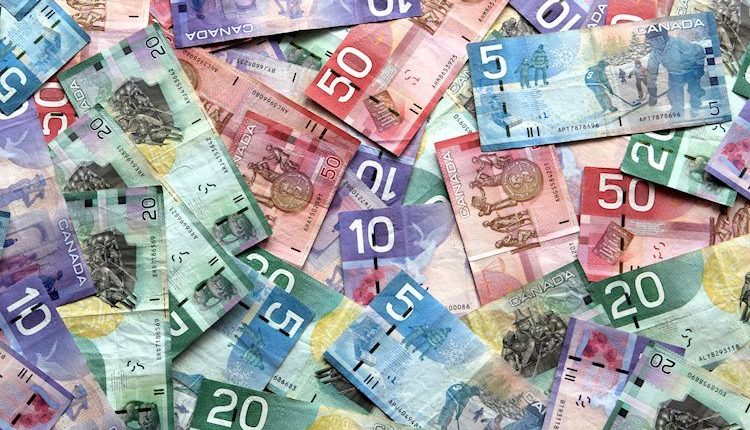- Canadian Dollar outflows continue for Tuesday as investors pile into the US Dollar.
- Canada PMIs, labor data still ahead later in the week, but US NFP to overshadow.
- Crude Oil prices are rebounding for Tuesday, providing limited support for the CAD.
The Canadian Dollar (CAD) continues to sink against the US Dollar (USD) as broad-market risk-off flows remain the overall theme for investors on Tuesday. Oil-dependent CAD is catching only minor support from Crude Oil prices, which are seeing a minor rebound after halting a three-day decline.
Canada has both Purchasing Manager Index (PMI) and Employment Rate figures due this week on Thursday and Friday respectively, but market impact will likely remain muted as investors jockey for position ahead of the US Non-Farm Payroll (NFP) data drop on Friday.
Daily Digest Market Movers: Canadian Dollar gives up further ground, USD/CAD probing above 1.3700
- The USD/CAD crossed the 1.3700 technical barrier early Tuesday, sending the pair to a daily high of 1.3736.
- The US Dollar remains well-bid across overly cautious markets as investor confidence shakes out.
- Rising US Treasury yields, faltering global growth outlook, supply-constrained rising Oil prices, and a short-term government funding stopgap for the US are all sending investors into the safe-haven USD.
- Crude Oil prices are rebounding after three straight days of declines as CAD tries to suture the bleed against the USD.
- Economists from several large banks are starting to caution that the USD/CAD could be poised for a rebound if market flows ease up.
- Economists at Scotiabank noted that a firm showing for Canada data this week is needed to bolster expectations of another Bank of Canada (BoC) rate hike.
- MUFG Bank economists don’t see the USD/CAD pair returning to the 1.3600 region until the end of the fourth quarter.
- The US-Canada rate differential remains the key theme to capping USD/CAD chart flows according to HSBC analysts.
Technical Analysis: Canadian Dollar hits 1.3736 as markets extend their risk-off dogpile into US Dollar
Canadian Dollar (CAD) selling peaked at an intraday high of 1.3736 in Tuesday trading, and US Dollar bulls are looking to build out a price floor from the 1.3700 handle.
The USD/CAD has risen nearly 2.5% since last Friday’s dip into 1.3417, where the pair saw a technical rejection from the 200-day Simple Moving Average (SMA).
A continued run up the charts will see the USD/CAD set for a challenge of 1.3860, a region that the pair hasn’t seen since March.
Hourly candles have the USD/CAD drifting steadily higher as short interest fails to push the pair back into the 34-hour Exponential Moving Average (EMA). Bullish momentum appears to be running out of steam, and the Relative Strength Index (RSI) is drifting out of overbought territory.
Sellers will want to build up enough momentum to send the pair back down to 1.3560 near the 100-hour SMA, while bidders will be looking to mark a new high for the day beyond 1.3736.
Canadian Dollar FAQs
The key factors driving the Canadian Dollar (CAD) are the level of interest rates set by the Bank of Canada (BoC), the price of Oil, Canada’s largest export, the health of its economy, inflation and the Trade Balance, which is the difference between the value of Canada’s exports versus its imports. Other factors include market sentiment – whether investors are taking on more risky assets (risk-on) or seeking safe-havens (risk-off) – with risk-on being CAD-positive. As its largest trading partner, the health of the US economy is also a key factor influencing the Canadian Dollar.
The Bank of Canada (BoC) has a significant influence on the Canadian Dollar by setting the level of interest rates that banks can lend to one another. This influences the level of interest rates for everyone. The main goal of the BoC is to maintain inflation at 1-3% by adjusting interest rates up or down. Relatively higher interest rates tend to be positive for the CAD. The Bank of Canada can also use quantitative easing and tightening to influence credit conditions, with the former CAD-negative and the latter CAD-positive.
The price of Oil is a key factor impacting the value of the Canadian Dollar. Petroleum is Canada’s biggest export, so Oil price tends to have an immediate impact on the CAD value. Generally, if Oil price rises CAD also goes up, as aggregate demand for the currency increases. The opposite is the case if the price of Oil falls. Higher Oil prices also tend to result in a greater likelihood of a positive Trade Balance, which is also supportive of the CAD.
While inflation had always traditionally been thought of as a negative factor for a currency since it lowers the value of money, the opposite has actually been the case in modern times with the relaxation of cross-border capital controls. Higher inflation tends to lead central banks to put up interest rates which attracts more capital inflows from global investors seeking a lucrative place to keep their money. This increases demand for the local currency, which in Canada’s case is the Canadian Dollar.
Macroeconomic data releases gauge the health of the economy and can have an impact on the Canadian Dollar. Indicators such as GDP, Manufacturing and Services PMIs, employment, and consumer sentiment surveys can all influence the direction of the CAD. A strong economy is good for the Canadian Dollar. Not only does it attract more foreign investment but it may encourage the Bank of Canada to put up interest rates, leading to a stronger currency. If economic data is weak, however, the CAD is likely to fall.
Read the full article here

